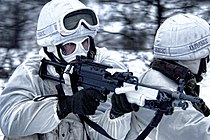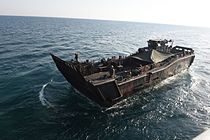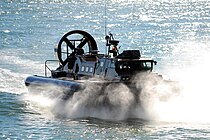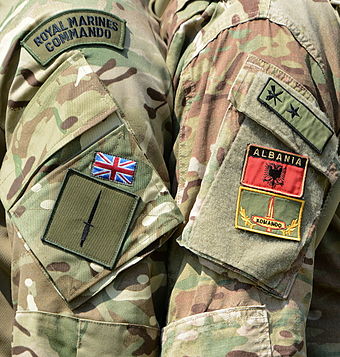Royal Marines: Difference between revisions
No edit summary Tags: Reverted Visual edit Mobile edit Mobile web edit |
Undo |
||
| Line 41: | Line 41: | ||
{{Royal Navy}} |
{{Royal Navy}} |
||
The '''Corps of Royal Marines''' ('''RM''') |
The '''Corps of Royal Marines''' ('''RM''') also known as the '''Royal Marines Commandos''' are the UK's special operations capable [[commando]] force, [[amphibious warfare|amphibious]] [[light infantry]] and also one of the [[:Category:Fighting Arms of the Royal Navy|five fighting arms]] of the [[Royal Navy]].<ref>{{cite web |title=The Royal Navy's Surface Fleet |url=https://www.royalnavy.mod.uk/About-the-Royal-Navy/~/media/Files/Navy-PDFs/About-the-Royal-Navy/Surface%20Fleet%20Information%20Leaflet.pdf |website=royalnavy.mod.uk |publisher=MOD UK |access-date=5 August 2018 |archive-url=https://web.archive.org/web/20121018112225/http://www.royalnavy.mod.uk/About-the-Royal-Navy/~/media/Files/Navy-PDFs/About-the-Royal-Navy/Surface%20Fleet%20Information%20Leaflet.pdf |archive-date=18 October 2012 |url-status=live |df=dmy-all }}</ref><ref>{{citation |url=https://www.royalnavy.mod.uk/our-organisation/the-fighting-arms/royal-marines |title=Royal Marines |publisher=Ministry of Defence |date=30 March 2018 |access-date=30 March 2018 |archive-url=https://web.archive.org/web/20180401160602/https://www.royalnavy.mod.uk/our-organisation/the-fighting-arms/royal-marines |archive-date=1 April 2018 |url-status=live |df=dmy-all }}</ref> The Corps of Royal Marines can trace their origins back to the formation of the [[English Army]]'s "Duke of York and Albany's maritime regiment of Foot" at the grounds of the [[Honourable Artillery Company]] on 28 October 1664.<ref name="Origins of Royal Marines">{{cite web |url=http://www.acoy.co.uk/royalmarineshistorytraditionalfactsprecispack1.pdf |title=Royal Marines History and Traditional Facts |publisher=Marine Society & Sea Cadet |access-date=22 May 2016 |archive-url=https://web.archive.org/web/20160705080815/http://www.acoy.co.uk/RoyalMarinesHistoryTraditionalFactsPrecisPack1.pdf |archive-date=5 July 2016 |url-status=live |df=dmy-all }}</ref> |
||
As a highly specialised and adaptable elite light infantry and commando force, Royal Marine Commandos are trained for rapid deployment worldwide and capable of dealing with a wide range of threats. The Corps of Royal Marines is organised into a light infantry brigade ([[3 Commando Brigade]]) and a number of separate units, including [[47 Commando (Raiding Group) Royal Marines]], and a company-strength commitment to the [[Special Forces Support Group]]. The Corps operates in all environments and climates, though particular expertise and training is spent on [[amphibious warfare]], [[arctic warfare]], [[mountain warfare]], [[expeditionary warfare]], and its commitment to the UK's [[rapid reaction force]]s. |
As a highly specialised and adaptable elite light infantry and commando force, Royal Marine Commandos are trained for rapid deployment worldwide and capable of dealing with a wide range of threats. The Corps of Royal Marines is organised into a light infantry brigade ([[3 Commando Brigade]]) and a number of separate units, including [[47 Commando (Raiding Group) Royal Marines]], and a company-strength commitment to the [[Special Forces Support Group]]. The Corps operates in all environments and climates, though particular expertise and training is spent on [[amphibious warfare]], [[arctic warfare]], [[mountain warfare]], [[expeditionary warfare]], and its commitment to the UK's [[rapid reaction force]]s. |
||
Revision as of 14:53, 12 August 2022
| Corps of Royal Marines | ||
|---|---|---|
First Sea Lord Admiral Sir Ben Key | | |
| Commandant General | Lieutenant General Robert Magowan[4] | |
| Corps Regimental Sergeant Major | Warrant Officer 1 Richard Angove | |
| Insignia | ||
| Non‑ceremonial flag |  | |
| Commando flash |  | |
 |
| His Majesty's Naval Service of the British Armed Forces |
|---|
| Components |
|
| History and future |
| Ships |
| Personnel |
|
| Auxiliary services |
The Corps of Royal Marines (RM) also known as the Royal Marines Commandos are the UK's special operations capable commando force, amphibious light infantry and also one of the five fighting arms of the Royal Navy.[5][6] The Corps of Royal Marines can trace their origins back to the formation of the English Army's "Duke of York and Albany's maritime regiment of Foot" at the grounds of the Honourable Artillery Company on 28 October 1664.[7]
As a highly specialised and adaptable elite light infantry and commando force, Royal Marine Commandos are trained for rapid deployment worldwide and capable of dealing with a wide range of threats. The Corps of Royal Marines is organised into a light infantry brigade (
Throughout its history, the Royal Marines have seen action in a number of major wars often fighting beside the
History
The Royal Marines traces its origins back to 28 October 1664 when at the grounds of the Honourable Artillery Company "the Duke of York and Albany's maritime regiment of foot" was formed.[7]
Early British Empire
On 5 April 1755, His Majesty's Marine Forces, fifty Companies in three Divisions, headquartered at

In 1788 a detachment of four companies of marines, under Major

In 1802, largely at the instigation of Admiral the
During the

In 1855 the infantry forces were renamed the Royal Marines Light Infantry (RMLI). During the
The Royal Marines also played a prominent role in the Boxer Rebellion in China (1900), where a Royal Marine earned a Victoria Cross.[21]
Status and roles
Through much of the 18th and 19th centuries Marine officers had a lower standing status than their counterparts in the Royal Navy. A short-lived[24] effort was made in 1907, through the common entry or "
By the early twentieth century the Royal Marines had achieved a high professional status, although there was a serious shortage of junior officers. Numbering about 15,000 during the Edwardian era,[26] enlistment for other ranks was for at least 12 years, with entitlement to a pension after 21 years of service. After basic training new recruits were assigned to one of three land-based divisions and from there to warships as vacancies arose.[27] From 1908 onwards one gun turret on each battleship was manned by RMA gunners. The RMLI continued their traditional role of providing landing parties and shore-based detachments. Specialist positions on board ship, such as postmen, barbers, lamp trimmers and butchers, were reserved for Royal Marines. After 1903 the Royal Marines provided bands for service on board battleships and other large vessels.[28]
World wars
First World War
During the
The Royal Marines also took part in the Zeebrugge Raid in 1918. Five Royal Marines earned the Victoria Cross in the First World War, two at Zeebrugge, one at Gallipoli, one at Jutland and one on the Western Front.[21]
Between the wars
After the war Royal Marines took part in the
Second World War
During the
In addition the Royal Marines formed Mobile Naval Base Defence Organisations (MNBDOs) similar to the
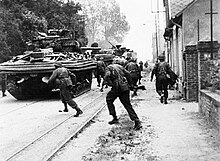
A total of four Special Service Brigades (redesignated Commando brigades in December 1944 as the "SS" abbreviation was unpopular) were raised during the war, and Royal Marines were represented in all of them. A total of nine RM Commandos (
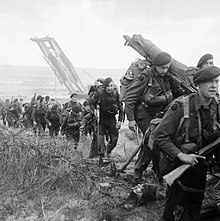
In January 1945, two further RM Brigades were formed, 116th Brigade and 117th Brigade. Both were conventional Infantry, rather than in the Commando role. 116th Brigade saw some action in the Netherlands, but 117th Brigade was hardly used operationally. In addition one Landing Craft Assault (LCA) unit was stationed in Australia late in the war as a training unit. In 1946 the Army Commandos were disbanded, leaving the Royal Marines to continue the Commando role (with supporting Army elements). A number of Royal Marines served as pilots during the Second World War. It was a Royal Marines officer who led the attack by a formation of Blackburn Skuas that sank the Königsberg. Eighteen Royal Marines commanded Fleet Air Arm squadrons during the course of the war, and with the formation of the British Pacific Fleet were well represented in the final drive on Japan. Captains and Majors generally commanded squadrons, whilst in one case Lt Colonel R.C. Hay on HMS Indefatigable was Air Group Co-ordinator from HMS Victorious of the entire British Pacific Fleet.[36]
Throughout the war Royal Marines continued in their traditional role of providing ships detachments and manning a proportion of the guns on Cruisers and Capital Ships. They also provided the crew for the UK's Minor Landing craft, and the Royal Marines Armoured Support Group manned Centaur IV tanks on D Day; one of these is still on display at Pegasus Bridge.[37]
Only one Marine (
Post-colonial era
The Corps underwent a notable change after 1945 however, when the Royal Marines took on the main responsibility for the role and training of the
43 Commando was active as amphibious infantry from 1961–68, and 41 Commando was disbanded in 1981.[42]
Cold War

During the
- Commandant General Royal Marines, London
- 3 Commando Brigade, Plymouth
- 40 Commando, Taunton
- 42 Commando, Bickleigh
- 45 Commando, Arbroath
- 29 Commando Regiment, Royal Artillery, Plymouth, one battery in Arbroath, (18× L118 light guns)
- 4 Assault Squadron, Plymouth (4× LCU Mk.9, 4× LCVP Mk.4, 2× Centurion BARV), served aboard HMS Fearless (L10)
- 539 Assault Squadron, Plymouth (4× LCU Mk.9, 4× LCVP Mk.4, 2× Centurion BARV), served aboard HMS Intrepid (L11)
- 59 Independent Commando Squadron, Royal Engineers, Plymouth, one troop in Arbroath
- RNAS Yeovilton, (12× Gazelle AH.1, 6× Lynx AH.1)
- 2 Raiding Squadron, Royal Marines (Reserve), Plymouth
- 131 Independent Commando Squadron, Royal Engineers (V), Plymouth
- 289 Commando Battery, Royal Artillery (V), Plymouth (6× L118 light guns)
- Special Boat Service, Poole, under operational control of United Kingdom Special Forces
- Comacchio Group, HMNB Clyde, guarded HMNB Clyde and the UK's naval nuclear weapons stored at RNAD Coulport
- Royal Marines Police, Plymouth
- Commando Training Centre Royal Marines, Lympstone
- Royal Marines Band Service RMSoM, Deal
- Royal Marines Reserve
Note: "(V)" denotes British Army reserve units.
Today
Personnel
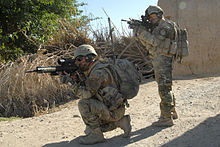
The Royal Marines are part of the Naval Service and under the full command of Fleet Commander. The rank structure of the Corps is similar to that of the British Army. Uniquely, in the Royal Marines, officers and other ranks undergo initial, commando and specialist training together at the Commando Training Centre, Royal Marines (CTCRM). Since 2017 women have been able to serve in all roles in the Royal Marines, though as of June 2019[update] none have passed the training.[44] On average, 1,200 recruits attend training courses at the Commando Training Centre Royal Marines every year.[45]
At its height in 1944 during the Second World War, more than 70,000 people served in the Royal Marines. Following the Allied victory the Royal Marines were quickly reduced to a post-war strength of 13,000. When
Equipment
- Light weapons
- The basic personal weapon of the Royal Marines is the C8SFW.[55]
- Armour
- The Royal Marines maintain no heavy armoured units, instead, they operate a fleet of lightly armoured and highly mobile vehicles intended for amphibious landings or rapid deployment. The primary Pinzgauer High Mobility All-Terrain Vehicle.[57]
- Artillery
- Field artillery support is provided by Commando-trained.[58]
- Aviation
- The Commando Helicopter Force of the Fleet Air Arm provides transport helicopters in support of the Royal Marines. It currently uses both Merlin HC4/4A medium-lift transport and Wildcat AH1 light transport/reconnaissance helicopters to provide direct aviation support for the Corps. In addition, the Royal Air Force provides Chinook heavy-lift and Puma HC2 medium-lift transport helicopters.[59]
- Vessels
- The Royal Marines operate a varied fleet of Swimmer Delivery Vehicle for special forces. Other smaller amphibious craft such as the Offshore Raiding Craft, Rigid Raider and Inflatable Raiding Craft are in service in much greater numbers.[60]
-
Royal Marines equipped for Arctic warfare during an exercise in Norway
-
BvS 10 Vikings of the Royal Marines Armoured Support Group on exercise
-
Royal Marines Landing Craft Utility (LCU) Mk10
-
A Royal Marines Landing Craft Vehicle Personnel (LCVP) Mk5
-
Royal Marines Landing Craft Air Cushion (LCAC)
Formation and structure
The overall head of the Royal Marines is
The operational capability of the corps comprises a number of battalion-plus sized units, of which five are designated as "commandos":[63]
- Commando Units
- 40 Commando, Royal Marines (known as Forty Commando) based at Norton Manor Barracks, Taunton, Somerset, England
- Bickleigh Barracks, Plymouth, Devon, England
- 45 Commando, Royal Marines (known as Four Five Commando) based at RM Condor, Arbroath, Angus, Scotland
- Maritime Security
- 43 Commando Fleet Protection Group, Royal Marines based at HM Naval Base Clyde, Helensburgh, Argyll and Bute (previously Comacchio Group).
- Intelligence, Surveillance and Target Acquisition
- Raiding and Assault
- 47 Commando (Raiding Group), Royal Marines based at RM Tamar, Devonport (previously 1 Assault Group RM)
- RNAS Yeovilton in Somerset, and is part of 539 Raiding Squadron.
- 47 Commando (Raiding Group), Royal Marines based at RM Tamar, Devonport (previously 1 Assault Group RM)
- Logistic Support
- Commando Logistic Regiment based at RM Chivenor, Devon
- Special Forces
- Special Boat Service based at RM Poole, Dorset (although Full Command is retained by CINCFLEET, Operational Command of SBS RM is assigned to Director Special Forces).
- Royal Marines Vanguard Strike Company, forming up in 2020 as a strike reaction force[65]
With the exception of the 43 Commando Fleet Protection Group and Commando Logistic Regiment, which are each commanded by a full
3 Commando Brigade

Operational command of the five commandos and the Commando Logistics Regiment is delegated to
43 Commando Fleet Protection Group Royal Marines, responsible for the security of the United Kingdom's nuclear deterrent and other security-related duties was originally outside the brigade, but was incorporated into it from April 2012.[67] It also provides specialist boarding parties and snipers for the Royal Navy worldwide, for roles such as embargo enforcement, counter-narcotics, counter-piracy and counter-insurgency activities of the Royal Navy. It is the largest unit in the brigade, at 790 strong.[67]
Independent elements
The independent elements of the Royal Marines are:[68]

- Commando Training Centre: This is the training unit for the entire corps, and consists of three separate sections:
- Commando Training Wing: This is the initial basic commando training section for new recruits to the Royal Marines, and the UK Forces All Arms Commando Course.
- Specialist Wing: This provides specialist training in the various trades which Marines may elect to join once qualified and experienced in a Rifle Company.
- Command Wing: This provides command training for both officers and NCOs of the Royal Marines.
- Commando Training Wing: This is the initial basic
- 47 Commando (Raiding Group) Royal Marines: Provides training in the use of landing craft and boats, and also serves as a parent unit for the three assault squadrons permanently embarked on the Royal Navy's amphibious ships.
- 4 Assault Squadron—HMS Bulwark
- Director Special Forces, UK Special Forces Group. It is commanded by a lieutenant colonel qualified as a swimmer canoeist. SBS responsibilities include water-borne operations, maritime counter-terrorism and other special forces tasks.
- Royal Marines Band Service provides regular bands for the Royal Navy and provides expertise to train RN Volunteer Bands. Musicians have an important secondary roles as medics, field hospital orderlies, CBRN specialists and any other roles that may be required of them. Personnel may not be commando trained, usually wearing the dark blue beret instead of green; until 2017, the band service was the only branch of the Royal Marines to admit women.
Structure of a commando
40 and 45 Commando are each organised into six companies, further organised into platoon-sized troops, as follows:[69]
- Command company
- Main HQ
- Tactical HQ
- Reconnaissance Troop with a sniper section
- Mortar Troop
- Anti-Tank (AT) Troop
- Medium Machine Gun Troop
- 2× Close Combat Companies
- Company Headquarters
- 3× Close Combat Troops
- 2× Stand Off Companies
- Company Headquarters
- Heavy Machine Gun (HMG) Troop
- AT Troop
- Close Combat Troop.
- Logistic Company
- A Echelon 1
- A Echelon 2
- FRT (Forward Repair Team)
- RAP (Regimental Aid Post)
- B Echelon
In general a rifle company Marine will be a member of a four-man fire team, the building block of commando operations. A Royal Marine works with their team in the field and shares accommodation if living in barracks. This structure is a recent development, formerly Commandos were structured similarly to British Army light infantry battalions.[70]
Amphibious Task Group
Formerly known as the Amphibious Ready Group, the Amphibious Task Group (ATG) is a mobile, balanced amphibious warfare force, based on a Commando Group and its supporting assets, that can be kept at high readiness to deploy into an area of operations. The ATG is normally based around specialist amphibious ships, most notably HMS Ocean, the largest ship in the British fleet until she was decommissioned and sold to Brazil in 2018. Ocean was designed and built to accommodate an embarked commando and its associated stores and equipment. The strategy of the ATG is to wait "beyond the horizon" and then deploy swiftly as directed by HM Government. The whole amphibious force is intended to be self-sustaining and capable of operating without host-nation support. The concept was successfully tested in operations in Sierra Leone.[71]
Commando Helicopter Force
The Commando Helicopter Force (CHF) forms part of the
Commando Forces 2030, Maritime Operations Commando & Future Commando Force

On 11 April 2017 the
Selection and training


Royal Marine Commandos are required to undergo the longest and one of the most physically demanding specialist infantry training courses in the world. Recruit training lasts for 36 weeks for Royal Marine Commandos and 60 weeks for Royal Marine Commando Officers. Potential recruits must be aged 16 to 32 (18 to 25 for Commissioned Officers)[81] and must undertake a series of interviews, medical tests, an eye/sight test, psychometric tests and a PJFT (Pre-joining fitness test).[82] As of late 2018 there is no restriction on women joining the Royal Marines.[83][44] Once a potential recruit passes these, enlisted recruits undertake a three-day selection course called PRMC (Potential Royal Marine Course) and potential officers undertake POC (Potential Officer Course) – both take place at the Commando Training Centre Royal Marines (CTCRM) in Lympstone, Devon. Officers must also take the Admiralty Interview Board (AIB).[84] Upon passing the three-day course, recruits then start basic recruit training (RT) at CTCRM.[82] A large proportion of training is carried out on Dartmoor's inhospitable terrain and Woodbury Common woodland.[85]
Throughout the recruit training, Royal Marines learn and develop many military skills such as weapons handling, marksmanship and proficiency with different firearms, personal administration, marching and parade ground skills, map reading and navigation, physical fitness and mental toughness development, fieldcraft skills such as camouflage and stalking, basic survival techniques, patrolling and sentry duty development, unarmed and armed close quarters combat (CQC), first aid, underwater escape, chemical biological radiological nuclear (CBRN) training, military communications and signals, teamwork skills, amphibious landings training, and leadership skills for officers to name a few.[86]
The best recruit to finish training is awarded the Kings Badge. King George V directed that his Royal Cypher, surrounded by a laurel wreath, would be known as the King's Badge, and would be awarded to the best all round recruit in the King's Squad, provided that he was worthy of the honour. The badge was to be carried on the left shoulder, and worn in every rank. The King's Badge is not awarded to every squad, and is only presented if a recruit measures up to the very exacting standards required.[87]
Throughout their career, a Marine can specialise in a number of different roles upon completion of their respective courses after spending one to two years as a general duties (GD) Marine. Examples of some specialisations and different courses includes the mountain leader (ML), physical training instructor (PTI), Assault Engineer (AE), Royal Marines police (RMP), sniper (S), medical assistant (MA), pilot, reconnaissance operator (RO), drill instructor (DL), driver (D), clerk (C), signaller (SI), combat intelligence (CI), armourer (A), and heavy weapons (HW). Royal Marines can also apply for swimmer canoeist/
Museum
The
Customs and traditions
The Royal Marines have a proud history and unique traditions. With the exceptions of "Gibraltar" and the laurel wreath for the Battle of Belle Island, their colours (flags) do not carry
The heraldic crest of the Royal Marines commemorates the history of the Corps. The Lion and Crown denotes a Royal regiment.
Encouraged by the Prince of Hesse, the garrison did more than could humanly be expected, and the English Marines gained an immortal glory
— referred to by Paul Harris Nicolas, Historical Record of the Royal Marine Forces[91]
There are no other battle honours displayed on the
The regimental quick march of the Corps is "

The Royal Marines are allowed by the
Uniforms
Modern Royal Marines uniforms are broadly similar to British Army uniforms but include a number of distinctive uniform items. These include the green "Lovat" shade of service dress uniform; the green beret (for those who have passed the commando course) or navy blue beret (for those who have not) with a scarlet patch behind the badge; dark blue parade dress worn with either the white Wolseley Pattern Helmet (commonly referred to as "pith helmet") or white and red peaked cap; the scarlet and blue mess dress for officers and senior non-commissioned officers; and the white hot-weather uniform of the Band Service.[94]
For historical information regarding Marine uniforms, see Uniforms of the Royal Marines.
Ranks and insignia
| Royal Marines officer rank insignia | ||||||||||||
|---|---|---|---|---|---|---|---|---|---|---|---|---|
| NATO Code | OF-10 | OF-9 | OF-8 | OF-7 | OF-6 | OF-5 | OF-4 | OF-3 | OF-2 | OF-1 | OF(D) | |

|

|

|

|

|

|

|

|

|

|

| ||
| Rank title: | General | Lieutenant-general | Major-general
|
Brigadier | Colonel | Lieutenant colonel | Major | Captain | Lieutenant | Second lieutenant | Officer cadet | |
| Royal Marines other rank insignia | |||||||||
|---|---|---|---|---|---|---|---|---|---|
| NATO Code | OR-9 | OR-8 | OR-7 | OR-6 | OR-5 | OR-4 | OR-3 | OR-2 | |

|

|

|

|

|

|

|
No insignia | ||
| Rank Title: | Warrant officer class 1 | Warrant officer class 2 | Colour sergeant | Sergeant | Corporal | Lance corporal | Marine | ||
| Abbreviation: | WO1 | WO2 | CSgt | Sgt | Cpl | LCpl | Mne | ||
Associations with other regiments and marine corps
- Argyll and Sutherland Highlanders
- Early connections date from Balaclava in the Crimean War and Lucknow during the Indian Rebellion of 1857, but the main association stems from World War II. In July 1940, after the fall of Dunkirk, the 5th Battalion, Argyll and Sutherland Highlanders served with the Royal Marine Brigade for over a year. When the battleships HMS Prince of Wales and HMS Repulse were sunk in December 1941, the Royal Marines survivors joined up with the remnants of the 2nd Battalion, in the defence of Singapore. They formed what became known as 'The Plymouth Argylls', after the association football team, since both ships were Plymouth manned. Most of the Highlanders and Marines who survived the bitter fighting were taken prisoner by the Japanese. The Royal Marines inter-unit rugby football trophy is the 'Argyll Bowl', presented to the Corps by the Regiment in 1941.[7]
- Princess of Wales's Royal Regiment
- The fore-bearer regiments of the Princess of Wales's Royal Regiment, 31st (Huntingdonshire) Regiment of Foot was initially raised as amphibious troops. They served as Marines for a period. To this day one officer from the Royal Marines serves with the PWRR and Vice Versa. Also the Royal Marine Lanyard is worn by all ranks in Service Dress and Number 2 Dress uniform and barrack dress of PWRR.[95]
- United States Marine Corps
- The Royal Marines and the United States Marine Corps have trained together or exchanged training on multiple occasions, sometimes as mixed units to further build cooperation.[96] In 2018, the Royal Marines won a friendly boxing tournament contested by fighters from both corps at the Royal Lancaster Hotel in London broadcast by Sky Sports.[97]
- Barbados Defence Force
- Close links have existed between the Royal Marines and the Barbados Defence Force since 1985 when a bond was established following a series of cross-training exercises in the Caribbean. The Alliance was approved by HM the Queen in 1992.[7]
- Netherlands Marine Corps
- The Royal Marines have close links with the Royal Netherlands Marine Corps, with whom they conduct NATO exercises throughout the year. Formed during the Anglo-Dutch Wars in 1665, the Dutch Marines distinguished themselves in raids on the English coast, where it is likely they met their future counterparts.[98] Units of the Royal Netherlands Marine Corps work in close co-operation with 3 Commando Brigade of the Royal Marines. Operational units of the Royal Netherlands Marine Corps are fully integrated into this brigade. This integration is known as the United Kingdom-Netherlands Landing Force and is a component of the United Kingdom-Netherlands Amphibious Force as a key strike force during the Cold War to strengthen the Nordic area.[99]
- French 9th Marine Infantry Brigade (former 9th Light Armoured Marine Brigade)
- The 9th Marine Infantry Brigade (9e Brigade d'Infanterie de Marine, 9e BIMa) is a Marine infantry brigade which is one of the two designated amphibious brigades in France. It is unique in being the only 'All Marine' Brigade in the French Army; the other amphibious brigade, 6th Light Armoured Brigade (6e Brigade Légère Blindée, 6e BLB), is composed of a mix of cap badges. 9e BIMa is also a light armoured brigade, formed of two Marine infantry regiments (2e RIMa and 3e RIMa — Régiments d'Infanterie de Marine) and a tank battalion.[100]
See also
- Royal Marines selection and training
- Royal Marines Reserve
- Royal Marines Museum
- Royal Marines Cadets
- Royal Marines Volunteer Cadet Corps
- RM Turnchapel
- List of active Royal Marines military watercraft
- List of serving senior officers of the Royal Marines
Notes
References
- ^ "Integrated Review of Security, Defence, Development and Foreign Policy: Future of the Royal Marines". lordslibrary.parliament.uk. 6 September 2021. Retrieved 3 May 2022.
- ^ "Royal Marines". YouTube. Retrieved 9 August 2022.
- ^ "The Integrated Review In Context: Defence and Security in Focus" (PDF). King's College, London. 1 October 2021. Retrieved 9 August 2022.
- ^ "New Head Royal Marines Takes Role". forces.net. 30 April 2021. Retrieved 30 April 2021.
- ^ "The Royal Navy's Surface Fleet" (PDF). royalnavy.mod.uk. MOD UK. Archived (PDF) from the original on 18 October 2012. Retrieved 5 August 2018.
- ^ Royal Marines, Ministry of Defence, 30 March 2018, archived from the original on 1 April 2018, retrieved 30 March 2018
- ^ a b c d e f "Royal Marines History and Traditional Facts" (PDF). Marine Society & Sea Cadet. Archived (PDF) from the original on 5 July 2016. Retrieved 22 May 2016.
- ^ a b Royal Marines Train In Californian Desert Archived 18 October 2012 at the Wayback Machine, mod.uk
- ^ Thompson, p. 3
- ^ "Major John Pitcairn". Silverwhistle. Archived from the original on 30 January 2016. Retrieved 30 January 2015.
- ^ Moore 1987, p.41
- S2CID 143644513.
- ^ The History of Biological Weapons Use: What We Know and What We Don’t DOI: 10.1089/hs.2014.0092
- ^ Warren, Christopher, Could First Fleet smallpox infect Aborigines? – a note (PDF), archived from the original (PDF) on 6 November 2013, retrieved 6 November 2013,
several authors – including Josephine Flood, Alan Frost, Charles Wilson and Judy Campbell – maintain that First Fleet smallpox did not cause the outbreak
- ^ a b c "The crest, colours, beret, nicknames and prayers of the Royal Marines". Royal Marines Museum. Archived from the original on 24 March 2012. Retrieved 30 January 2015.
{{cite web}}: CS1 maint: unfit URL (link) - ^ "Admiralty: Royal Marines, Woolwich Division: Correspondence, Registers and Papers". National Archives. Archived from the original on 13 April 2017. Retrieved 12 April 2017.
- ^ "Per Mare Per Terram – the Royal Marines 1793–1815". Napoleon Series. Archived from the original on 27 June 2015. Retrieved 30 January 2015.
- ^ "The Royal Marines in the War of 1812". Archived from the original on 30 September 2015. Retrieved 30 January 2015.
- ^ "The Battle of Fort Bowyer, Alabama". Explore Southern History. Archived from the original on 14 February 2015. Retrieved 30 January 2015.
- ^ a b c d "The Victoria Cross and the Royal Marines". Royal Marines Museum. Archived from the original on 15 January 2014. Retrieved 30 January 2015.
{{cite web}}: CS1 maint: unfit URL (link) - ^ Chappell, pp. 14–15
- ^ "Second Anglo-Chinese War ("Opium war") of 1856 – 1860 (part 2)". William Loney. Archived from the original on 3 May 2012. Retrieved 30 January 2015.
- ISBN 978-0-946771-32-5.
- ^ "Class Warfare and the Selborne Scheme: The Royal Navy's battle over technology and social hierarchy". The Mariner's Mirror. 4 November 2014. Archived from the original on 2 January 2016. Retrieved 30 January 2015.
- ISBN 978-0-946771-32-5.
- ISBN 978-0-946771-32-5.
- ISBN 978-0-946771-32-5.
- ^ "The RMLI move to, and deployment at, Gallipoli". The Long, Long Trail. Archived from the original on 27 April 2015. Retrieved 30 January 2015.
- ^ Lamb, Dave (9 September 2006). "Mutiny and resistance in the Royal Navy, 1918-1930". Lib.com. Retrieved 26 November 2020.
- ^ London Gazette, 20 July 1923
- ^ London Gazette, 16 October 1923
- ^ Mountbatten, p. 107
- ^ "D-Day: Heroic battle in Port-en-Bessin". The Telegraph. 20 May 2009. Archived from the original on 13 June 2015. Retrieved 30 January 2015.
- ^ "Operation Infatuate". Combined Operations. Archived from the original on 6 February 2015. Retrieved 30 January 2015.
- ^ "Obituary:Colonel Ronnie Hay". The Telegraph. 24 December 2001. Archived from the original on 2 January 2016. Retrieved 30 January 2015.
- ^ Bingham, John (5 August 2008). "D-Day tanks found on seabed". The Telegraph. Archived from the original on 2 January 2016. Retrieved 30 January 2015.
- ^ "Remembering the secret mission of Cockleshell Heroes". BBC. 31 March 2011. Archived from the original on 2 January 2016. Retrieved 30 January 2015.
- ^ "History of RM deployments". 2009. Archived from the original on 5 July 2011.
- ^ Royal Marines Museum – Suez deployment Archived 30 December 2009 at the Wayback Machine (PDF)
- ^ Simpson, Aislinn (14 April 2009). "The 22 Royal Marines who took on Argentine Falklands invasion force". The Telegraph. Archived from the original on 4 April 2015. Retrieved 30 January 2015.
- ISBN 978-1-84603-372-8.
- ^ "Royal Marines". British Army units 1945 on. Archived from the original on 5 June 2017. Retrieved 2 July 2017.
- ^ a b Drewett, Zoe (23 June 2019). "First female Royal Marine suspends training after leg injury".
- ^ "Marine dies after illness at base". BBC. 3 November 2004. Retrieved 30 December 2017.
- ^ Nicholas van der Bijl and Nick Bijl, The Royal Marines 1939–93, Osprey Publishing, 1995
- ^ gov.uk MoD – Royal Navy & Royal Marines quarterly pocket brief Archived 29 November 2014 at the Wayback Machine, October 2014. See table 1.
- ^ "Securing Britain in an Age of Uncertainty: The Strategic Defence and Security Review" (PDF). HM Government. 19 October 2010. Archived from the original (PDF) on 22 December 2010. Retrieved 19 October 2010.
- ^ a b "Royal Air Force Aircraft and Weapons page 44" (PDF). Royal Air Force. 2013. Archived from the original (PDF) on 10 July 2017.
- ^ a b c "Royal Air Force Aircraft and Weapons page 45" (PDF). Royal Air Force. 2013. Archived from the original (PDF) on 10 July 2017.
- ^ a b "Royal Air Force Aircraft and Weapons page 46" (PDF). Royal Air Force. 2013. Archived from the original (PDF) on 10 July 2017.
- ^ a b "Royal Air Force Aircraft and Weapons page 48" (PDF). Royal Air Force. 2013. Archived from the original (PDF) on 10 July 2017.
- ^ "Royal Air Force Aircraft and Weapons page 49" (PDF). Royal Air Force. 2013. Archived from the original (PDF) on 10 July 2017.
- ISBN 978-0-87364-002-2.
- ^ Lye, Harry (7 November 2019). "Royal Navy limits commitment to Littoral Strike Ship development". Naval-technology.com. Retrieved 13 December 2019.
- ^ IISS 2010, p. 168.
- ^ Joint Committees On Transportation Holds Public Hearing Re: Trans 123 Archived 5 March 2009 at the Wayback Machine www.wisconsin-pinzgauers.org
- ^ "29th Regiment RA". British Army units 1945 on. Archived from the original on 21 April 2014. Retrieved 10 May 2014.
- ^ a b "Commando Helicopter Force (CHF) | Royal Navy". www.royalnavy.mod.uk. Archived from the original on 31 August 2017. Retrieved 27 July 2017.
- ^ "Royal Marines - Landing Craft". Royal Navy. Archived from the original on 23 June 2014. Retrieved 15 June 2014.
- ^ "Senior Naval Staff". Archived from the original on 14 March 2009.
As the Commander-in-Chief Fleet, a position he took up in November 2007, Mark Stanhope has full command of all deployable Fleet units, including the Royal Marines.
- ^ "Fleet Battle Staff". Royal Navy. Archived from the original on 17 March 2011. Retrieved 20 May 2016.
{{cite web}}: CS1 maint: unfit URL (link) - ^ a b "3 Commando Brigade". Royal Navy. Archived from the original on 1 April 2016. Retrieved 4 April 2016.
- ^ "30 Commando Information Exploitation Group". Royal Navy. Archived from the original on 7 May 2010. Retrieved 2 June 2010.
- ^ "New Royal Marines Unit To 'Shape' Future Operations". Forces Network. 20 July 2020. Retrieved 21 July 2020.
- ^ "Bridge Card – 11 February 11" (PDF). Archived (PDF) from the original on 16 March 2011. Retrieved 21 April 2011.
- ^ Other Units of the Royal marines Archived 2 August 2009 at the Wayback Machine on Royal Navy website
- ^ Extract from The Globe & Laurel, November–December 2000, archived from the original on 5 November 2010
- ^ Commando Units To Be Reshaped Archived 11 June 2011 at the Wayback Machine, Navy News article
- ^ COMUKAMPHIBFOR General Description Archived 16 March 2011 at the UK Government Web Archive
- ^ "Commando Helicopter Force webpage". Archived from the original on 24 June 2009. Retrieved 17 June 2009.
- ^ "Royal Marines to be restructured in line with growing Royal Navy". GOV.UK. 11 April 2017. Archived from the original on 15 April 2017. Retrieved 17 April 2017.
- ^ "Commando Forces 2020". Royal Navy. Archived from the original on 18 April 2017. Retrieved 17 April 2017.
- ^ "UK Royal Marines stand up programme office to lead Future Commando Force". janes.com. London. 12 June 2019. Retrieved 19 June 2019.
- ^ "Young engineers design "invisible commandos"". Royal Navy. 26 August 2019. Retrieved 27 August 2019.
- ^ "Royal Marines of the Future". royalnavy.mod.uk. Royal Navy. 27 August 2019. Retrieved 27 August 2019.
ROYAL MARINES OF THE FUTURE Imagined by Britain's best and brightest engineers
- ^ Nicholls, Dominic (26 June 2020). "UK's Future Commando Force: a radical and 'lethal' new unit to fight threats across the globe". Daily Telegraph. Retrieved 27 June 2020.
- ^ "New commando uniform for Royal Marines". Royal Navy. 27 June 2020. Retrieved 28 June 2020.
- ^ "Royal Marines Commandos Go MultiCam". Joint Forces News. 26 June 2020. Retrieved 28 June 2020.
- ^ "What Does It Take to Be a Royal Marine? Royal Navy Jobs". Royalnavy.mod.uk. Archived from the original on 29 January 2017. Retrieved 31 January 2017.
- ^ a b Recruitment Process Royal Marines Archived 24 February 2012 at the Wayback Machine, royalnavy.mod.uk
- ^ "Royal Marines to welcome first women recruits in 2019". Naval Today. 26 October 2018. Archived from the original on 12 April 2019. Retrieved 12 April 2019.
- ^ Admiralty Interview Board (PDF) Archived 27 January 2012 at the Wayback Machine, royalnavy.mod.uk
- ^ "Woodbury | information and guide to Woodbury Devon UK". Devonlink.co.uk. Archived from the original on 25 August 2012. Retrieved 20 November 2016.
- ^ "Royal Marines Commando Training". Royal Navy. Archived from the original on 31 December 2017. Retrieved 30 December 2017.
- ^ "Kings Squad". Royal Navy. Archived from the original on 24 November 2012. Retrieved 2 September 2014.
- ^ Commando specialisations Archived 17 January 2012 at the Wayback Machine, royalnavy.mod.uk
- ^ "Royal Marines Museum to be moved to new home in Portsmouth Historic Dockyard". Portsmouth News. 17 October 2013. Archived from the original on 11 June 2016. Retrieved 22 May 2016.
- ^ a b "The Royal Marines" (PDF). NATO. Archived (PDF) from the original on 22 December 2015. Retrieved 17 December 2015.
- ^ "The Capture of Gibraltar - 24 July 1704" (PDF). Royal Navy. Archived (PDF) from the original on 4 March 2016. Retrieved 17 December 2015.
- ^ "Sword presentation Royal Marine Corps at the Royal Marines Museum". Archived from the original on 22 December 2015. Retrieved 17 December 2015.
- ^ "Royal Marines". Archived from the original on 22 December 2015. Retrieved 17 December 2015.
- ^ "Helmet, Wolseley pattern (Tropical) S/P 1912 Royal Marines". Imperial War Museum. Archived from the original on 22 December 2015. Retrieved 17 December 2015.
- ^ "The East Surrey Regiment - Marine Service of the Regiment, War of the Spanish Succession". Queen's Royal Surreys. Archived from the original on 27 June 2016. Retrieved 24 February 2017.
- ^ Marines vs. Royal Marines Athletic Competition United States Marine Corps on YouTube
- ^ HIGHLIGHTS: Royal Marines vs US Marine Corps Boxing Tournament Sky Sports Boxing on YouTube
- ^ Second Anglo-Dutch War: Raid on the Medway by Kennedy R. Hickman, About.com (WebCite archive)
- ^ "HMS Bulwark arrives in the Netherlands to mark amphibious pact". Royal Navy. 8 May 2013. Archived from the original on 17 November 2015. Retrieved 30 January 2015.
- ^ "Devon Royal Marines in French exercise". Ministry of Defence. 12 March 2013. Archived from the original on 25 February 2017. Retrieved 24 February 2017.
Bibliography
- Akins, Thomas Beamish (1895). History of Halifax. Brookhouse Press. ISBN 978-1298600462.
- Brooks, Richard; Little, Matthew (2008). Tracing Your Royal Marine Ancestors: A Guide for Family Historians. Pen & Sword, Barnsley. ISBN 978-1844158690.
- Chappell, Mike (2004). Wellington's Peninsula Regiments (2): The Light Infantry. Oxford: Osprey Publishing. ISBN 978-1-84176-403-0.
- Chartrand, Rene (2002). Colonial American Troops, 1610–1774. Vol. 1. Osprey Publishing. ISBN 978-1841763248.
- Dutton, Jim. "The Royal Marines Today," RUSI Journal, Vol. 145, No. 4, August 2000, 21-24.
- Edye, Lourenço (1893). The Historical Records of the Royal Marines. Vol. v. 1. London: Harrison & Sons.
- Francis, David (1975). The First Peninsular War: 1702–1713. Ernest Benn. ISBN 978-0510002053.
- Gleig, George Robert (1827). The campaigns of the British army at Washington and New Orleans in the years 1814-1815. John Murray, London.
- Heidler, David; Heidler, Jeanne (2004). Encyclopedia of the War Of 1812. Naval Institute Press. ISBN 978-1591143628.
- Moore, John (1989). The First Fleet Marines. University of Queensland Press. ISBN 978-0702220654.
- Mountbatten, Lord Louis (1943). Combined Operations: The Official Story Of The Commandos. New York, The Macmillan Company.
- Nicolas, Paul (1845). Historical record of the Royal marine forces. Thomas and Boone, London.
- Lenihan, Padraig (2008). Consolidating Conquest, Ireland 1603-1727. Pearson Education. ISBN 978-0582772175.
- Thompson, Julian (2001). The Royal Marines, From Sea Soldiers to a Special Force. Pan Books. ISBN 978-0330377027.
- Carter, B L (2013). A Short history of The Royal Marines. Royal marines Historical Society. ISBN 978-1908123053.
External links
- Official website
- Royal Marines History website
- Royal Marines Band Service website
- Royal Marines Volunteer Cadet Corps (RMVCC) Portsmouth website
- Download Royal Marines Registers of Service (1842–1925). The National Archives official website
- Potential Royal Marines Commando forum (for men wishing to join)
- "Rum Ration": The Navy Network – unofficial website for the Royal Navy, Royal Marines, and Royal Fleet Auxiliary
- Royal Marines Museum website
- Marine Society website
- Royal Navy ranks, professions, and trades in World War 2, including Royal Marines
- Royal Navy Battle Honours including Royal Marine Corps Memorable Dates, 1939–1945

